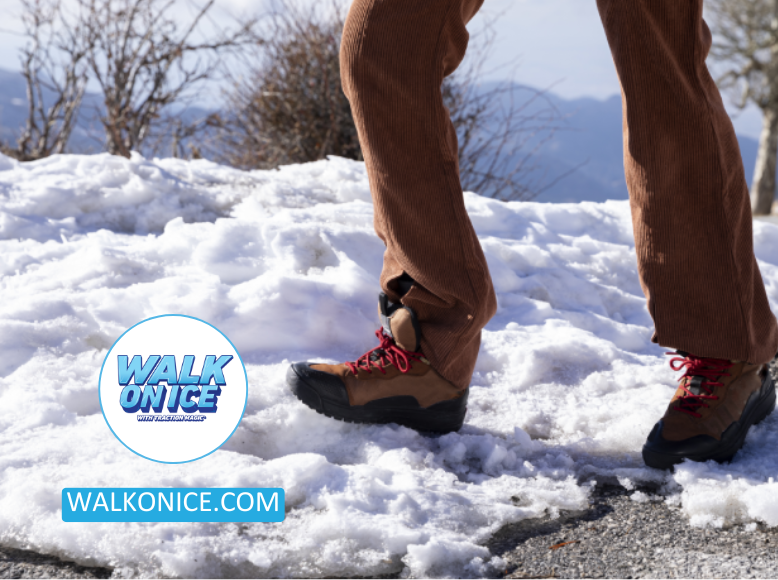When And How Can You Walk On Ice

Winter is here, and with it comes the inevitable slippery ice. We’ve all been there: you first wonder when can you walk on ice, then you’re just walking out your door to get some groceries, when suddenly you slip on a patch of black ice and hit your head on the cement stairs. In the past, this might have resulted in nothing more than a bruised ego and a few minutes wasted cleaning up blood from your forehead. But now it could be much worse! Thanks to advances in research we have created a solution that can take away these woes forever. And if that sounds like good news—well, then read on.
The Best Way to Walk on Ice
Walking on ice requires a unique approach to ensure your safety. Here are some essential tips on the best way to walk on ice:
- Take Smaller Steps: Reduce your stride length to maintain better balance. Smaller steps can help prevent slipping.
- Bend Your Knees Slightly: Slightly bending your knees lowers your center of gravity, making it easier to stay balanced.
- Walk Slowly and Cautiously: Rushing on icy surfaces is a recipe for disaster. Take your time and be mindful of your steps.
- Keep Your Feet Flat: Avoid leaning forward or backward. Keep your feet flat on the ground for stability.
When Can You Walk On Ice?
The first thing you’ll want to do is decide how much traction you need. If it’s just a short distance, like from the door of your house to the street, or from one side of a parking lot to another, then maybe all you need is something that’s going to increase friction between your feet and the ice. This could be as simple as wearing shoes with good treads on them and not going too fast across the slippery surface.
Traction agents are better than boots on ice. Traction agents are more effective than boots for workers who need to walk on ice. The best way to be prepared for black ice, snow-covered pavement, and other icy conditions is with both boots and a traction agent.
If you work in an area where there’s likely going to be some sort of walking hazards like snow, mud, or even puddles, then having something that gives you some extra grip on those surfaces is important so that no one gets hurt while doing their job safely!
Walk on Ice is made up of geo-crystals. ‘Absorbers’ soak up water while ‘grippers’ grip the snow to create a non-slip surface. Walk On Ice is safe for your pets and children, unlike salt-based products. It is non-corrosive and will not damage your concrete and asphalt. The all-natural components of this product do not burn your vegetation and keep your greenery healthy.
Get ready for winter with Walk On Ice instant traction on snow and ice
How To Walk On Icy Surfaces?
Put on your winter gear: You can’t just wear regular shoes and walk on the ice. You need to have winter boots that are thick enough to support you, but also thin enough to slide easily over the ice without sinking too deep.
If you’re going to be walking on the ice, it’s best to go with a friend who can help you if something unexpected happens, like if you fall through or get stuck.
Is Kitty Litter Good for Ice or Just a Winter Myth?
After footwear and traction agents, many people wonder, is kitty litter good for ice? The idea has been around for decades, but it’s more myth than solution. While kitty litter does provide some grit temporarily, most clay-based litters clump up when wet, turn into mush, and then refreeze into a slick mess. Silica litter, on the other hand, doesn’t clump but scatters easily and doesn’t stay in place long enough to be useful.
So yes, kitty litter might work for a few minutes on a short icy patch, but it’s not reliable or clean. A traction product like Walk On Ice is designed for this exact purpose. It grips the ice instantly without leaving behind the sludge, dust, or residue that kitty litter does. If safety is the goal, it’s better to skip the litter box filler and use a dedicated ice traction aid.
Cleats for Walking on Ice: Do They Really Help?
Another popular question is about cleats for walking on ice. Cleats and ice spikes can be useful, especially for people who spend a lot of time outdoors in icy conditions. They attach directly to your shoes, giving your feet extra bite into hard-packed snow or ice. For outdoor workers, delivery drivers, or hikers, cleats can reduce the risk of falls dramatically.
However, cleats also have their downsides. They need to be taken off indoors, since the same spikes that grip ice can become dangerously slippery on hard surfaces like tile or wood. They’re also not always convenient for quick trips outside—few people want to strap on spikes just to grab the mail. That’s why many people use cleats in combination with surface treatments like Walk On Ice: cleats protect your feet, and Walk On Ice makes the ground safer for everyone.
How to Make Stairs Not Slippery in Winter
Flat sidewalks are bad enough, but icy stairs can be downright dangerous. Homeowners often ask, how to make stairs not slippery when freezing rain or snow creates hazardous steps. Some try outdoor stair mats or adhesive treads, which add grip but still need to be cleared of snow. Others turn to salt, which can damage concrete and wood over time.
A safer, cleaner solution is to sprinkle Walk On Ice directly on the steps. It creates instant traction without corroding surfaces or leaving stains. For wooden stairs, it’s especially helpful since salt and chemicals can strip finishes and shorten their lifespan. Combine traction products with regular snow clearing, and your stairs become far less of a winter hazard.
Sand on Ice: Old-School Traction with Modern Drawbacks
Finally, let’s talk about sand on ice—a method that has been around forever. Sand does add grit and can make walking easier in the short term. That’s why many cities still use it on roads. But sand doesn’t actually bond with ice, meaning it scatters quickly and requires frequent reapplication. Once snow melts and refreezes, the sand often gets buried underneath, making it useless.
There’s also the cleanup issue. Come spring, leftover sand ice collects in drains, lawns, and sidewalks, creating extra work. Compared with modern traction agents, sand feels more like a temporary patch than a dependable solution. Walk On Ice avoids all these problems by sticking where it’s needed and staying effective, no matter how often the surface refreezes.
Conclusion
So, when it comes to walking safely on ice, the answer isn’t just about how you move but also what you use to prepare the ground. Tricks like kitty litter and sand on ice have been passed down for years, but their drawbacks—mess, inconsistency, and environmental impact—make them less than ideal. Cleats for walking on ice and stair mats can help, but they don’t always fit into everyday routines. And questions like how to make stairs not slippery remind us that not all solutions protect the surfaces we rely on.
This is where Walk On Ice stands out. It’s safe, natural, and instantly effective—providing traction whether you’re stepping onto a frozen porch, clearing icy stairs, or navigating a slick driveway. Unlike quick hacks, it’s designed for real winter conditions and keeps both people and pets safe. Ice may be inevitable in winter, but slipping doesn’t have to be. With knowledge, preparation, and the right tools, you can walk through the season with confidence.
FAQs
Other Ice Melt Products
Safe Paw
The Original and #1 Selling Pet and Child Safe Ice Melt for over 20 years. Guaranteed environmentally safe – will not harm waterways and sensitive wetlands. All products are made in the USA.

Safe Thaw
Imagine an ice melt you can put down and never worry about. It won’t harm pets, kids, and your property. That’s Safe Thaw. Unlike anything else on the market, Safe Thaw can change how winter affects our planet.



